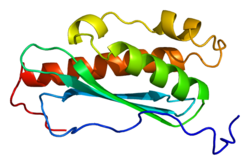Clinical significance
ISCU mutations have been found in patients with a mitochondrial myopathy called hereditary myopathy with lactic acidosis (HML). [11] It is also known as hereditary myopathy with exercise intolerance, Swedish type; [11] myopathy with deficiency of succinate dehydrogenase and aconitase; [11] myoglobinuria due to abnormal glycolysis; [11] myopathy with deficiency of ISCU; [10] Larsson–Linderholm syndrome; [12] and Linderholm myopathy. [13]
This disease is a result of a deficiency of ISCU that corresponds to the deficiency of mitochondrial iron-sulfur proteins and impaired muscle oxidative metabolism. [7] Characteristics of mitochondrial myopathy with deficiency of ISCU may include lifelong exercise intolerance in which exertion can cause tachycardia, dyspnoea, cardiac palpitations, shortness of breath, fatigue, pain of active muscles, rhabdomyolysis, myoglobinuria, elevated lactate and pyruvate, decreased oxygen utilization, may have a pseudoathletic appearance of hypertrophic calf muscles, and possibly weakness. [14] [15] [8] [9] [10] [16] Primarily affecting the skeletal muscles, rarely there is also hypertrophic cardiomyopathy and ptosis (drooping eyelid). [11] [17]
Biopsy of skeletal muscle shows deficiency of succinate dehydrogenase and aconitase, abnormal iron deposition and lipid droplet accumulation in the mitochondria. Histochemical studies show impaired respiratory chain complexes I, II, and III, impairing oxidative phosphorylation. Electromyography normal or myopathic increased polyphasic MUAPs. EMG results may be dynamic: more likely to have increased polyphasic MUAPs after exercise. [14] There has been documented temporary restoration of succinate dehydrogenase in regenerating muscle after an episode of rhabdomyolysis; however, the effect does not last. [18]
The disease is limited to muscle, with fibroblasts from skin biopsy being unaffected. As non-muscle tissues are unaffected, this necessitates the need for muscle biopsy when DNA testing using saliva or blood is inconclusive. [19] [17]
Genetics
This disorder has been associated with several different mutations and is inherited predominantly in an autosomal recessive manner. It was originally believed to affect only those of northern Swedish ancestry, however the disease has been found in those of Norwegian and Finnish decent as well. The carrier rate in northern Sweden has been estimated at 1:188. [15] ISCU deficiency has been linked to pathogenic variants including intronic variants c.418+382G>C, g.7044G>C, [19] and IVS5+382 G>C [20] as well as a c.149G>A missense mutation in exon 3. [21] The intronic mutations have been suggested to activate a cryptic splice site, resulting in the production of a splice variant that encodes a putatively non-functional protein. [10]
In 2016, an Italian male was found to have a de novo autosomal dominant mutation, c.287G>T (p.Gly96Val) in the ISCU gene, that caused hereditary mitochondrial myopathy with lactic acidosis (HML). This mutation resulted in a similar phenotype as seen in the recessive form of the disease. [17]
Interactions
ISCU has been shown to have 235 binary protein-protein interactions including 79 co-complex interactions. ISCU appears to interact with ISCS, NUP62, SDHB, HPRT1, CCDC172, GOLGA2, IKZF1, KRT40, AGTRAP, NECAB2, FAM9B, BANP, LNX1, MID2, GOLGA6L9, ccdc136, KRT34, SPERT, PICK1, YWHAB, SFN, mbl, E7, dnaX, hscB, MAPk-Ak2, hale, and cv-c. [22]
This page is based on this
Wikipedia article Text is available under the
CC BY-SA 4.0 license; additional terms may apply.
Images, videos and audio are available under their respective licenses.






